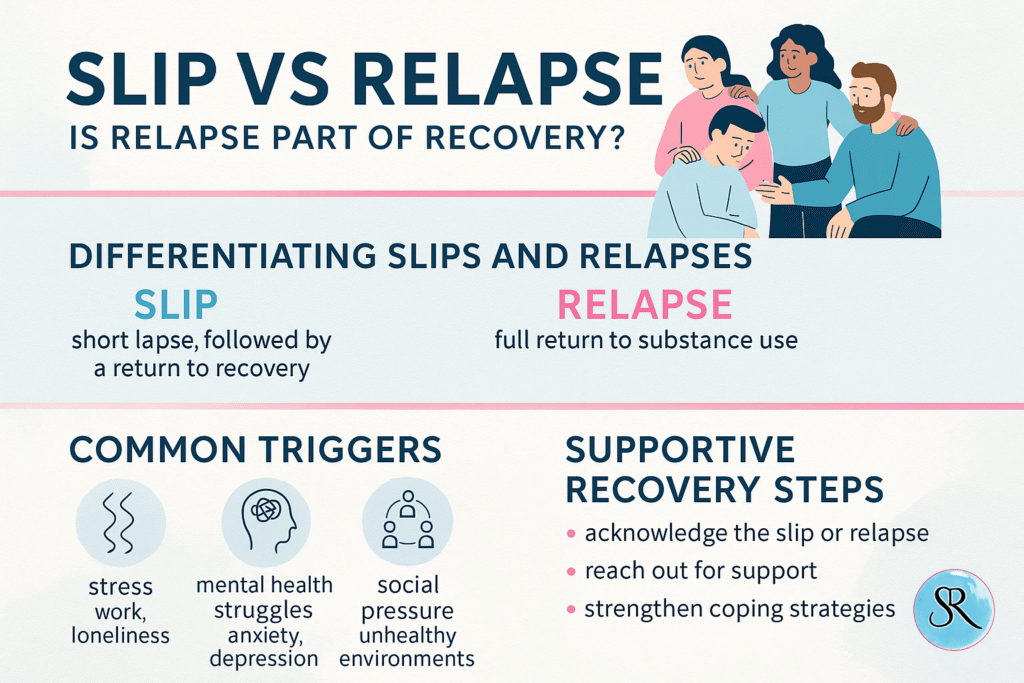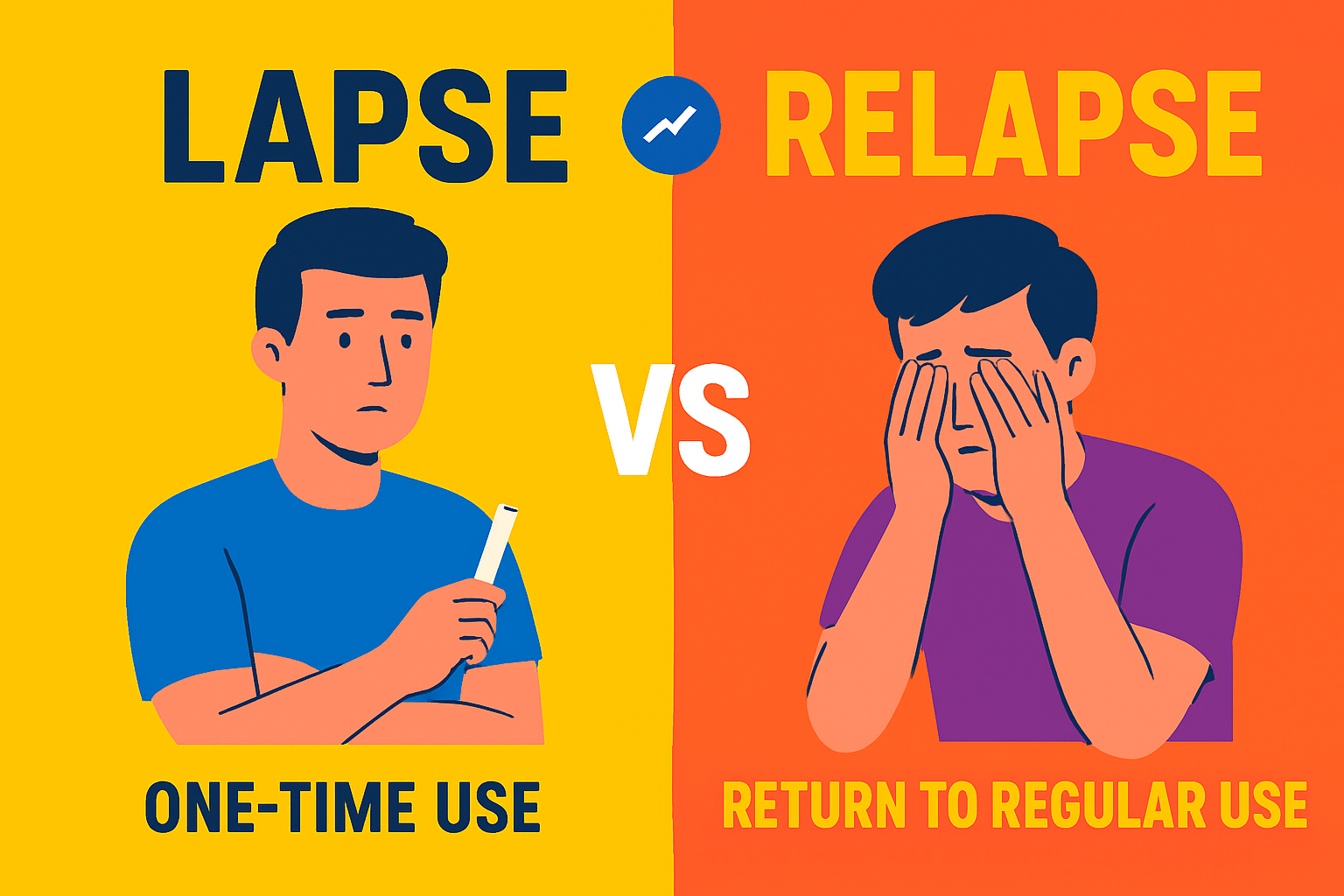Stopping cocaine can be a hard thing to do. Especially if you’ve been using it for a long time. The longer you’ve been using it for, the harder it would likely be to quit. But it’s not the same for everyone. And it’s certainly not impossible! It is possible! Especially with the right mindset, help and tools.
Clinicians and researchers use the terms lapse (or slip) and relapse to describe very different events, each with different clinical implications and different ways to respond. This article explains the difference, the science behind it, how clinicians think about stages of relapse, what increases risk, and most importantly, what to do if a lapse (or relapse) happens to you (or someone you know).
The Difference Between a Slip, a Lapse and a Relapse

When you’re recovering from addiction, it’s easy to think that any return to use means failure. But that’s not true. Addiction recovery is a process, not a straight line, and it’s common to experience temporary setbacks. Understanding the difference between a slip, a lapse, and a relapse helps you respond effectively — and stay on track toward lasting recovery.
What Is a Slip?
A slip is the smallest, briefest form of setback. It might be a single, momentary use — for example, taking one line of cocaine or one drink, often impulsively and with immediate regret.
A slip usually happens without intention and without abandoning recovery goals. It’s a sign that your defences were down, not that you’ve failed.
Example:
“I was stressed, I used once, and I immediately felt bad about it. I don’t want to do it again.”
Key takeaway: A slip is a warning signal. It’s a chance to learn what went wrong — a cue to strengthen your coping strategies, reach out for support, and recommit to sobriety.
What Is a Lapse?
A lapse is a short-term return to substance use after a period of abstinence. It might last a few hours or a few days but doesn’t yet return to old habits or full-blown addiction.
Unlike a slip, a lapse may involve a conscious choice — for example, deciding to use after a stressful week — but the person still wants to stop and usually returns to recovery soon after.
Example:
“I used over the weekend, but on Monday I called my counsellor and got back into meetings.”
Key takeaway: A lapse doesn’t erase progress. What matters most is how quickly you act to stop it from turning into a relapse. Early intervention — contacting support, attending a meeting, or revisiting your relapse prevention plan — makes all the difference.
What Is a Relapse?
A relapse is a full return to previous patterns of addiction — regular, uncontrolled use and loss of motivation to stop. It’s not just one event; relapse usually develops gradually, often following emotional and mental warning signs.
Practical Definitions of Lapse Vs Relapse
These definitions are how major addiction bodies and peer-reviewed studies commonly distinguish the two. Exact wording can vary between studies, but the essential distinction — brief vs sustained return — is common.
- Lapse (slip): a brief, isolated return to cocaine use (for example, one episode of using after a period of abstinence) that is time-limited and from which the person returns to their recovery goals. A lapse does not necessarily mean long-term return to previous patterns.
- Relapse: a sustained return to prior levels or patterns of cocaine use — a loss of recovery where abstinence goals are abandoned and drug use becomes more frequent or uncontrolled again. Relapse often follows a longer, gradual process (emotional → mental → physical stages).
Why the distinction matters?
- Clinical response differs. A lapse can be handled by immediate safety planning, re-engaging supports, and adjusting a relapse-prevention plan. A relapse often requires re-starting or intensifying treatment.
- Psychological impact. People who interpret a lapse as “I’ve failed completely” are more likely to spiral into relapse. Treating a lapse as a learning moment lowers risk.
- Research and outcome measures. Trials and studies track lapses and relapses differently—interpretation of treatment success depends on those definition.
The Relapse Process – A Gradual Model
Relapse is not usually a single event. Influential clinical models describe three progressive stages before full-blown relapse:
- Emotional relapse: changes in mood and self-care (isolation, stress, poor sleep) without conscious thoughts about using.
- Mental relapse: internal conflict—thinking about using, glamorizing past use, planning, or bargaining. Cravings increase.
- Physical relapse: the actual return to full time chronic drug use.
This staged model is useful to know about because interventions at the emotional or mental stage can often prevent the physical relapse.
Biology and risk factors that make relapse likely (brief)
Cocaine produces long-lasting changes in brain circuits for reward, stress and self-control. Those neurobiological changes increase vulnerability to cue-triggered craving and impulsive use even months after stopping. Predictors of poorer outcomes include longer history of use, younger age, high baseline craving, co-occurring mental health problems, and weak social supports. Biomarker and cue-reactivity research aims to predict who is most at risk, but clinical risk assessment still relies on history and current functioning.
How Clinicians and Programs Treat Lapses vs Relapse
After a lapse (recommended immediate actions):
- Safety first: ensure the person is physically safe (no overdose risk, access to medical help if unwell). If there is risk of overdose, call emergency services.
- Avoid “all or nothing” thinking: reframe the lapse as a signal to use supports and adjust the plan rather than proof of failure. This reduces likelihood of escalation.
- Use practical tools: contact a sponsor/therapist, re-activate contingency management or monitoring, increase frequency of meetings or check-ins, re-start coping skills (urge surfing, distraction, behavioural activation).
- Brief clinical reassessment: identify triggers, whether medication or comorbidity management needs review, and whether more structured treatment (e.g., higher level of care) is needed.
After a Relapse
- Comprehensive reassessment and treatment re-engagement are usually required: consider detox if medically indicated, residential care if needed, evidence-based psychosocial interventions (Cognitive Behavioural Therapy, contingency management), and treatment for co-occurring disorders.
- Address underlying drivers (mental health, social stressors, housing, legal/financial issues).
- Consider evidence-based pharmacological adjuncts where available (research for cocaine pharmacotherapy is ongoing; behavioural therapies currently have the strongest evidence base).
What the evidence says about prevention and treatment
- Behavioural therapies like Cognitive-Behavioural Therapy (CBT) and contingency management (CM) have the best evidence for reducing cocaine use and preventing relapse. CM (vouchers, prizes for negative tests) is among the most effective behavioural approaches.
- Relapse prevention strategies (identifying triggers, coping skills, social supports, structured aftercare) reduce the chance that a lapse turns into relapse.
- Biomarker and neuroimaging research is active but not yet providing routine clinical tests that reliably predict relapse for individuals. Clinical risk assessment remains key.
Real life examples of a lapse vs a relapse
Lapse example: After using cocaine for about 3 months, I go drug-free for a few months after. I go to a party, and use cocaine once later that night, I feel guilty about it. I tell people about it to make myself accountable for it and reach out to a therapist or sponsor the next day. I attend extra meetings and stay abstinent thereafter. (This is a lapse/slip.)
Relapse example: After using cocaine for about a year, but then stopping the use of it for about a month, Ben starts planning to use, skips meetings, uses repeatedly over several weeks, and returns to previous frequency and patterns. (This is a relapse and needs treatment re-engagement.)
Things that commonly cause a lapse and can be intervened on
- Strong cues (people/places associated with cocaine) and stress.
- Unmanaged mental health symptoms (depression, anxiety, trauma).
- Changes in routine or social isolation.
- Overconfidence (“I can handle one use”), or conversely, extreme self-blame after a small slip.
- Interventions: identify and avoid cues when possible, rehearse coping strategies, treat co-occurring mental health problems, involve supportive peers/family, and use structured programmes (CM, CBT).
Practical advice if you or someone you know has had a lapse
- Don’t view it as a final failure. Research and clinical guidance emphasize quick response over despair. A lapse can be a pivotal moment to strengthen recovery planning.
- Check for immediate physical danger. Cocaine can cause acute medical problems—if there’s chest pain, severe agitation, fainting, or breathing problems get emergency care.
- Reach out to supports immediately. Contact a trusted clinician, peer group (AA/NA or Cocaine Anonymous), sponsor, or crisis service.
- Make a concrete plan for the next 48–72 hours: increased meeting frequency, daily check-ins, remove access to money/contacts that enable use.
- Reassess treatment needs. If lapses are repeated or use escalates, re-engage formal treatment.
Language matters — avoid shame, use clarity
Calling a brief slip a “complete failure” increases the chance of relapse. Clinicians encourage neutral, practical language: “That was a lapse — here’s how we’ll respond and reduce the chance it becomes a relapse.” Language that reduces shame helps people re-engage supports quickly.
Bottom line about what a lapse and what a relapse is:
- A slip = a one time isolated use that was done in error without much thought behind it.
- A lapse = short, return to use; relapse = A return to prior patterns but not permanently.
- A relapse = a return to full time use and habit.
The difference is important because the immediate clinical response, psychological meaning, and treatment needs differ. Quick, compassionate, practical steps after a lapse dramatically improve the odds that the person will remain on their recovery path. Effective prevention and management combine behavioural treatments (CBT, contingency management), relapse-prevention planning, social supports, and clinical care for co-occurring problems.
Key Takeaway
Recovering from cocaine addiction is not a straight line (pun unintended) it’s a journey marked by progress, learning, and resilience. Understanding the difference between a lapse and a relapse can mean the difference between a brief setback and a full return to addiction. A lapse is a short slip — a momentary use that can serve as a powerful reminder to strengthen your recovery plan. While a relapse is a sustained return to old patterns that often requires renewed treatment and support. Recognizing early warning signs, responding quickly, and seeking help without shame are what truly protect long-term recovery. Every step — even the missteps — can be part of moving forward. The key is to act fast, stay connected, and never forget that recovery is not about perfection; it’s about persistence. #wedorecover #overcome

Leave a Reply